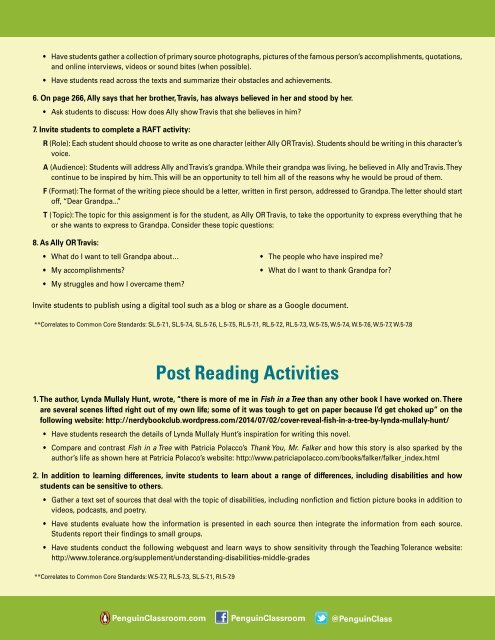FishInATree_lessonplans_Final_LR
FishInATree_lessonplans_Final_LR
FishInATree_lessonplans_Final_LR
Create successful ePaper yourself
Turn your PDF publications into a flip-book with our unique Google optimized e-Paper software.
• Have students gather a collection of primary source photographs, pictures of the famous person’s accomplishments, quotations,<br />
and online interviews, videos or sound bites (when possible).<br />
• Have students read across the texts and summarize their obstacles and achievements.<br />
6. On page 266, Ally says that her brother, Travis, has always believed in her and stood by her.<br />
• Ask students to discuss: How does Ally show Travis that she believes in him<br />
7. Invite students to complete a RAFT activity:<br />
R (Role): Each student should choose to write as one character (either Ally OR Travis). Students should be writing in this character’s<br />
voice.<br />
A (Audience): Students will address Ally and Travis’s grandpa. While their grandpa was living, he believed in Ally and Travis. They<br />
continue to be inspired by him. This will be an opportunity to tell him all of the reasons why he would be proud of them.<br />
F (Format): The format of the writing piece should be a letter, written in first person, addressed to Grandpa. The letter should start<br />
off, “Dear Grandpa...”<br />
T ( Topic): The topic for this assignment is for the student, as Ally OR Travis, to take the opportunity to express everything that he<br />
or she wants to express to Grandpa. Consider these topic questions:<br />
8. As Ally OR Travis:<br />
• What do I want to tell Grandpa about…<br />
• My accomplishments<br />
• My struggles and how I overcame them<br />
• The people who have inspired me<br />
• What do I want to thank Grandpa for<br />
Invite students to publish using a digital tool such as a blog or share as a Google document.<br />
**Correlates to Common Core Standards: SL.5-7.1, SL.5-7.4, SL.5-7.6, L.5-7.5, RL.5-7.1, RL.5-7.2, RL.5-7.3, W.5-7.5, W.5-7.4, W.5-7.6, W.5-7.7, W.5-7.8<br />
Post Reading Activities<br />
1. The author, Lynda Mullaly Hunt, wrote, “there is more of me in Fish in a Tree than any other book I have worked on. There<br />
are several scenes lifted right out of my own life; some of it was tough to get on paper because I’d get choked up” on the<br />
following website: http://nerdybookclub.wordpress.com/2014/07/02/cover-reveal-fish-in-a-tree-by-lynda-mullaly-hunt/<br />
• Have students research the details of Lynda Mullaly Hunt’s inspiration for writing this novel.<br />
• Compare and contrast Fish in a Tree with Patricia Polacco’s Thank You, Mr. Falker and how this story is also sparked by the<br />
author’s life as shown here at Patricia Polacco’s website: http://www.patriciapolacco.com/books/falker/falker_index.html<br />
2. In addition to learning differences, invite students to learn about a range of differences, including disabilities and how<br />
students can be sensitive to others.<br />
• Gather a text set of sources that deal with the topic of disabilities, including nonfiction and fiction picture books in addition to<br />
videos, podcasts, and poetry.<br />
• Have students evaluate how the information is presented in each source then integrate the information from each source.<br />
Students report their findings to small groups.<br />
• Have students conduct the following webquest and learn ways to show sensitivity through the Teaching Tolerance website:<br />
http://www.tolerance.org/supplement/understanding-disabilities-middle-grades<br />
**Correlates to Common Core Standards: W.5-7.7, RL.5-7.3, SL.5-7.1, RI.5-7.9<br />
PenguinClassroom.com<br />
PenguinClassroom<br />
@PenguinClass


